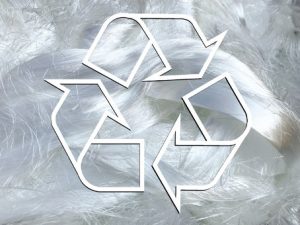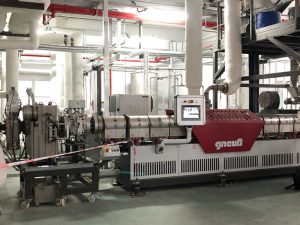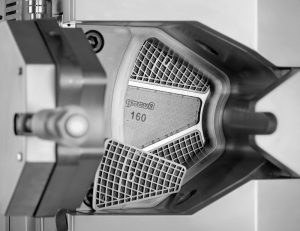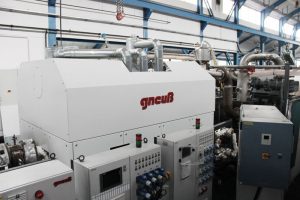 Key components and efficient retrofit solutions for plant modernization in PET fiber extrusion.
Key components and efficient retrofit solutions for plant modernization in PET fiber extrusion.
TW Special Report
Breathable sports and outdoor clothing are in vogue. Combined with the “fast fashion motto” and the “mass instead of class principle”, this is creating increased demand for PET fibers worldwide. This, in turn, leads to an increase in production waste, as this is automatically generated during fiber production. For ecological and economic reasons, the fiber residues must be appropriately processed and reused, which in some cases poses major challenges for fiber manufacturers and processors. Several customers, including large fiber manufacturers in China and Belarus, have therefore decided to use key components from Germany-based Gneuss Kunststofftechnik GmbH. With these they were able to convert existing fiber lines with low investment costs, so that the complete fiber waste can be processed into high quality fibers. And this is even possible for the production of drawn yarns such as POY or FDY, where the use of recycled material has up to now not been possible.
In the past 20 years, total textile production has doubled, and from 2000 to 2016, the use of polyester for clothing alone rose from 8.3 to 21.3 million tonnes worldwide. At the same time, the public’s call for the avoidance of plastic waste is becoming louder and legal directives of the European Union are intended to put a stop to plastic waste. For example, in addition to the collection of plastic, glass, paper and metal, a separate collection system for textiles is to be implemented in all EU countries by 2025 to enable high-quality recycling. In addition, product manufacturers are being made more responsible through the environmental protection strategy of Extended Producer Responsibility (EPR). They are to ensure the entire life cycle of their product from manufacture to disposal so that goals such as ecological design and resource efficiency can be achieved more quickly. In addition to the recyclability of products, the use of recycled materials is one way to achieve these goals. However, this is precisely where problems often arise:
The demand for the increased use of recycled materials in textiles requires a sufficient and regular availability of these materials. Well available on the market is the recycled PET from beverage bottles, which is available in very good quality due to the clean collection systems. However, the increased use of r-PET, especially for packaging applications and textile fiber production, has led to a strong increase in demand in recent years, so that in addition to the increased market price, other recycled materials must now be used.
Possible Retrofit Of Key Components
Production processes that were previously designed only for the processing of virgin material and thus achieved consistently high qualities under known conditions, are now severely disturbed or interrupted by contamination and strongly fluctuating material qualities at a higher recycling rate. Constant mechanical properties and uniform dyeability of the fibers or special requirements such as very fine fibers or use in direct body contact can no longer be achieved with the existing production lines. Therefore, plants are required which on the one hand can process recycled material — even in lower quality — and on the other hand can generate a high-quality end product without impurities. This is exactly where the German company Gneuss comes in with its machine components for PET processing. The MRS Extruder with its high degassing and decontamination performance, powerful and automatically operating Rotary Filtration Systems, an Online Viscometer as well as the polycondensation unit Jump, which can ensure a targeted viscosity build-up of the PET melt of up to 0.3 dl/g, are available. Each of these machine components is available individually or in combination and can be retrofitted into an existing production line to adapt it to the changed requirements. In this way an ideal result can be achieved with comparatively low investment costs.

Main Component MRS Extruder
The extruder has a special task when processing PET fiber residues, since the plastic must not only be melted and homogenized, but if possible, also dehumidified and freed of volatile components if possible. While post-consumer waste can contain mainly moisture and a wide variety of solid dirt particles, production waste from fiber manufacture usually contains spinning oils, which are important for processing but make recycling more difficult. Regardless of which form of thermal cleaning of the waste material is required, the Multi Rotation System Extruder from Gneuss Kunststofftechnik takes over this task.
This is due to its special processing-technical design based on a single-screw extruder. Thanks to the enormously large melt surface created in the multi-screw section of the extruder, a high degassing and decontamination performance can be achieved and spinning oils can be effectively removed. No thermal pre-treatment of the residues is necessary. Among others, this was a good reason for the Belarusian processor Mogilevkhimvolokno located in Mogilev, one of the largest Eastern European producers of staple fibers, to retrofit an MRS 90 to its existing line. With a capacity of around 350 kg/h, all agglomerated fiber residues arising in production are processed, decontaminated and then re-polymerised to PET with a defined IV value in a polycondensation reactor without any further preparation. The situation is similar at the Chinese fiber producer Suzhou Shenghong Fiber Co. Ltd which operates an MRS 130 with a capacity of up to 800 kg/h. Here, too, the fiber waste is first shredded, melted in the MRS and thermally cleaned before it is brought back to the desired IV value in the polycondensation reactor and then processed into POY and FDY yarns. For the first time, stretched fibers with a high recycled content can be produced in this way.
MRS extruders are in use worldwide for processing PET waste materials. This is also the case with the South American company Valerio, which operates an MRS 90 with a capacity of 450 kg/h to produce staple fibers from very dirty bottle flakes.
Mechanical Cleaning Indispensable
Especially when using heavily contaminated bottle flakes, as is the case with the South American Gneuss customer, mechanical melt cleaning is indispensable. Valerio decided in favour of an RSFgenius 90 which, like all melt filtration systems from Bad Oeynhausen, operates with a rotating filter disc.
Especially in recycling applications, low material losses and infrequent filter element changes are important in order to ensure a high efficiency of the overall process. Therefore, the RSFgenius not only operates pressure- and process-constantly, but also carries out the cleaning of the filter elements fully automatically by means of an integrated back-flushing system. For this purpose, a small amount of filtered melt is regularly shot through the dirty screen by a high-pressure impulse over a narrow gap. The quantity required for this is freely adjustable and in practice corresponds to about 0.01 to 1 percent (with very high contamination) of the throughput. This means that the filter elements can be reused up to 400 times, depending on the filter fineness, which means fully automatic filtration without the need for personnel for several weeks in some applications.

Even the two major fiber producers in Belarus and China are convinced by the machine component “filtration system,” which is also available as a separate unit and can be integrated into any existing line. They use an RSFgenius 90 resp. an RSFgenius 175 according to their throughput capacity and thus ensure a clean melt. This is especially essential for fiber production, as foreign particles could clog the spinneret and cause fiber breakage, which in turn would greatly reduce production efficiency.

Further Key Components Available
With its enormous know-how in PET processing, Gneuss not only advises its customers – which is very important especially for retrofit solutions — the machine manufacturer is always working on the further development of its machine components. In addition to the online viscometer, which records and controls the melt viscosity during production and, via a control system, readjusts the entire process in case of fluctuating viscosity, the polycondensation reactor Jump is one of the latest new developments. It is flanged directly to the extrusion unit and, with its sophisticated processing-technical concept, ensures a targeted viscosity build-up of the PET melt. The Jump thus represents a compact, economical and fast alternative to conventional SSP systems and enables the direct return of the residual materials into the production process. It can also be retrofitted to an existing line at any time.
August 13, 2020




